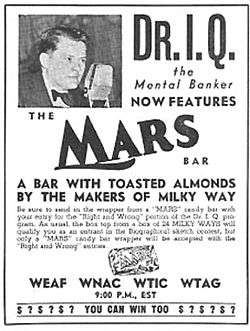Dr. I.Q.
| Doctor IQ | |
|---|---|
 | |
| Genre | Game show |
| Presented by |
James McClain (NBC Radio; January–October 1954) Lew Valentine (ABC Radio) Jay Owen (November 1953-January 1954) Tom Kennedy (1958-1959) |
| Narrated by |
Bob Shepard (1953-1954) Bill Ewing (1958-1959) |
| Country of origin | United States |
| Production | |
| Location(s) |
Various locations throughout the United States (1939-1950) Elysee Theater, New York City (1953-1954) ABC Television Center, Studio D, Los Angeles (1958-1959) |
| Release | |
| Original network |
NBC (Radio) ABC (Radio; 1953-1954, 1958-1959) |
| Original release | April 10, 1939 – March 23, 1959 |
Dr. I.Q. (aka Dr. I.Q., the Mental Banker and Doctor I.Q.) is a radio and television quiz program. Remembered as radio's first major quiz show, it popularized the catch phrase "I have a lady in the balcony, Doctor."
Radio
Over decades, the program's sponsors were Mars Candy, the Vick Chemical Company and Embassy Cigarettes. The radio series did not have a set studio. Instead, it traveled from city to city and broadcast from large concert halls and theaters. Thus, the audience was typically composed of residents from the surrounding area. Microphones were positioned throughout the audience. The quizmaster, Dr. I.Q., delivered silver dollars to audience members who correctly answered his fast-paced questions. The series began April 10, 1939 on the Blue Network with singer-announcer Lew Valentine as Dr. I.Q. Later quizmasters in the role of Dr. I.Q. were Jimmy McClain and Stanley Vainrib. The radio version aired until November 29, 1950 on the NBC and ABC networks. Valentine and McClain were also the hosts of Dr. I.Q. Jr., a juvenile version heard on NBC from 1941 to 1949.
The basic premise of the game involved assistants who wandered the theater looking for audience members to play the game. When the assistant found someone willing to play, he or she would say, "I have a gentleman in the balcony, Doctor!" or something similar. The host would then say, depending on the difficulty of the question: "Two (more or less) silver dollars and a box of Mars Bars if you can answer this!" Then he would pose a general-knowledge question to the contestant. A correct answer would win the stated dollar amount and candy in the first part of the game and $20 in the second part; incorrect answers would result in a $1 consolation prize. All prizes were paid in silver dollars. A home listener was selected each week to play the game via telephone.
At some point during the show, a jingle would play, and the contestant would get a chance to spin the "Wisdom Wheel," which would contain prize amounts from $1 to $100, each of which corresponded to a question whose difficulty increased with the prize amount. Other features were the "Biographical Sketch" and the "Thought Twister". For "The Lady in the Balcony" a female contestant in the theater balcony was asked a series of five questions. She would be allowed five incorrect answers. If she had any misses still available after five questions, she would return the following week to face five more questions with the remaining misses in play. If she was able to survive four weeks without incorrectly answering five questions, she won a jackpot prize.
Television
The television version ran on ABC from November 4, 1953 to October 17, 1954 and again from December 15, 1958 to March 23, 1959. The first host was Jay Owen. However, beginning January 18, 1954, McClain began hosting again. Tom Kennedy, who went on to become one of the top game show hosts in the country, hosted the 1958-59 version. Art Fleming, later the first host of Jeopardy!, was an assistant during the original run.
The television version did not tour to various cities. The first run of the television show was broadcast from the Elysee Theater in New York City, while the second run was broadcast from Studio D of the ABC Television Center in Los Angeles.
Episode status
Only one episode is known to exist of the 1953-54 version, and it is with McClain as host. Four episodes exist with Kennedy (including a probable pilot taped on October 15, 1958) along with a pilot for a television version of Dr. I.Q. Jr.[1]
References
Sources
External links
- Doctor IQ in The Internet Archive's Old-Time Radio Collection
- Doctor IQ Junior in The Internet Archive's Old-Time Radio Collection
- Dr. I.Q. at the Internet Movie Database
- A public domain TV episode of Dr. I.Q. at the Internet Archive